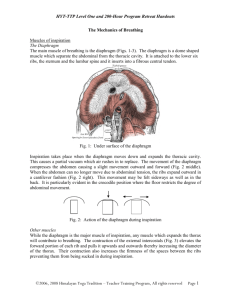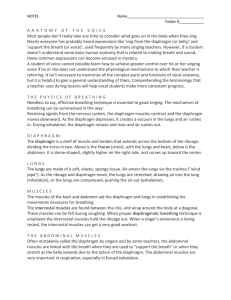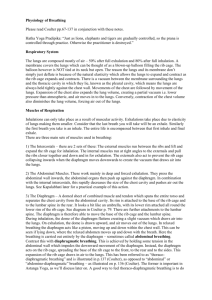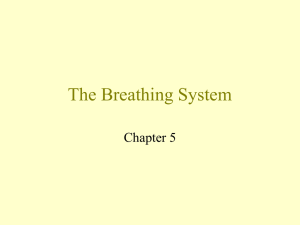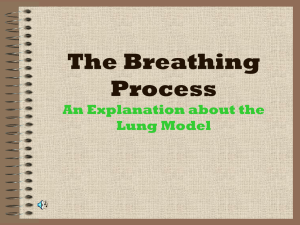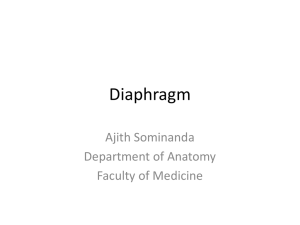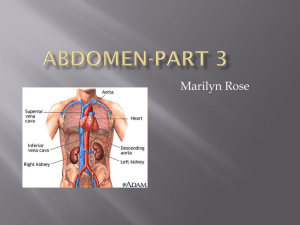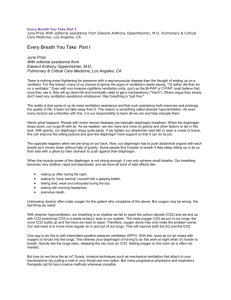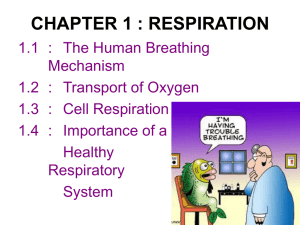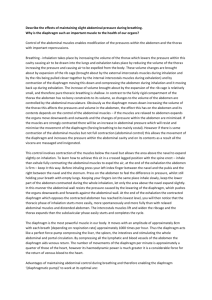Maria Ribeiro, L1 Assignment 11 Date: Assignment #11 -
advertisement
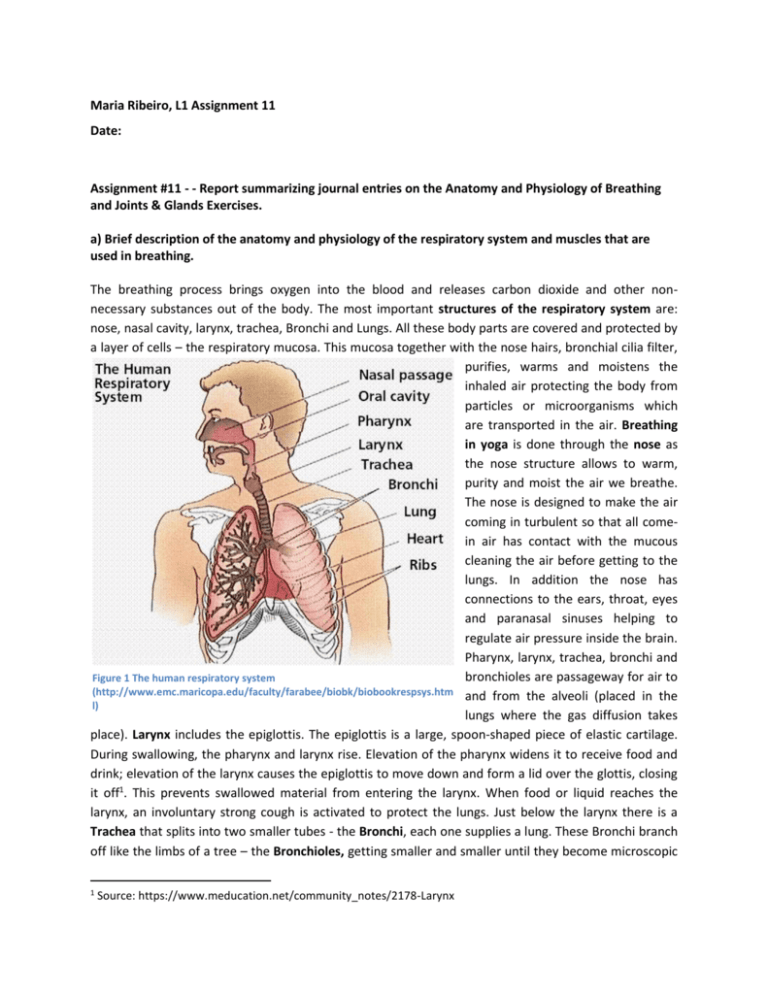
Maria Ribeiro, L1 Assignment 11 Date: Assignment #11 - - Report summarizing journal entries on the Anatomy and Physiology of Breathing and Joints & Glands Exercises. a) Brief description of the anatomy and physiology of the respiratory system and muscles that are used in breathing. The breathing process brings oxygen into the blood and releases carbon dioxide and other nonnecessary substances out of the body. The most important structures of the respiratory system are: nose, nasal cavity, larynx, trachea, Bronchi and Lungs. All these body parts are covered and protected by a layer of cells – the respiratory mucosa. This mucosa together with the nose hairs, bronchial cilia filter, purifies, warms and moistens the inhaled air protecting the body from particles or microorganisms which are transported in the air. Breathing in yoga is done through the nose as the nose structure allows to warm, purity and moist the air we breathe. The nose is designed to make the air coming in turbulent so that all comein air has contact with the mucous cleaning the air before getting to the lungs. In addition the nose has connections to the ears, throat, eyes and paranasal sinuses helping to regulate air pressure inside the brain. Pharynx, larynx, trachea, bronchi and bronchioles are passageway for air to Figure 1 The human respiratory system (http://www.emc.maricopa.edu/faculty/farabee/biobk/biobookrespsys.htm and from the alveoli (placed in the l) lungs where the gas diffusion takes place). Larynx includes the epiglottis. The epiglottis is a large, spoon-shaped piece of elastic cartilage. During swallowing, the pharynx and larynx rise. Elevation of the pharynx widens it to receive food and drink; elevation of the larynx causes the epiglottis to move down and form a lid over the glottis, closing it off1. This prevents swallowed material from entering the larynx. When food or liquid reaches the larynx, an involuntary strong cough is activated to protect the lungs. Just below the larynx there is a Trachea that splits into two smaller tubes - the Bronchi, each one supplies a lung. These Bronchi branch off like the limbs of a tree – the Bronchioles, getting smaller and smaller until they become microscopic 1 Source: https://www.meducation.net/community_notes/2178-Larynx in size. At the end of these bronchioles there are tiny sacs of air called Alveoli. The alveoli have very thin walls allowing the exchange of oxygen and carbon dioxide through diffusion to and from blood capillaries. Although the control of the respiration can be done by the voluntary nervous system, it is normally done by autonomic/involuntary nervous system. The control occurs through nerve impulses which originate in the respiratory center at the medulla of the brain. These impulses cause the contraction of the diaphragm and intercostals muscles allowing automatic inhalation. When impulses cease, the muscles relax and exhalation occurs. The respiratory center at the brain receives information from receptors spread all around the body that measure the concentration of carbon dioxide. This allows the respiration rate to increase when the concentration of carbon dioxide is high and to decrease when the concentration of this gas is low. The diaphragm is a key muscle in respiration it spans the entire torso and separates the chest cavity from the abdominal cavity. It is a sheet of combined muscle and tendon which is shaped like an umbrella or a dome. Pulmonary ventilation, i.e. inspiration and expiration, is caused by changes in the pressure within the thoracic cavity. This is achieved by contraction and relaxation of diaphragm, the external intercostals, and the interchondral part of the internal intercostal muscles. There are a range of other muscles that support respiration such as sternocleidomastoid and scalene muscles. Thus Inhalation is activated through the contraction of the diaphragm. This causes the diaphragm to press down on the abdomen and to enlarge the thoracic cavity. This action lowers the air pressure inside the lungs enabling involuntary inhale. The external intercostals muscles Figure 2: Gas exchange at the alveoli (source: www.britannica.com) support inhalation as they contract drawing ribs closer together and expanding the chest. Exhalation is activated when the diaphragm and internal intercostals muscles relax decreasing the size of thoracic cavity deflating the lungs and causing the air to move outwards. b) How do you feel your diaphragm muscle and breath in the cobra, in twisting postures and in the child pose. Discover and describe the anatomical parts involved in breathing in cobra. Cobra is a fine position to feel the movements of the diaphragm during inhale and exhale: With each inhalation the diaphragm contracts pushing the abdominal region down and against the floor, resulting in a lift of the torso; with each exhalation the diaphragm relaxes and the contents of the abdominal region retrocede to their original position leading to the lowering of the torso. If we do not use our arms to raise the torso in cobra and we stabilize the lower back by firmly hold the hips and thighs the diaphragm will aid the lower back muscles in the lifting up of the torso. The cobra and makarasana are good positions to teach beginners diaphragmatic breath, because these asanas constrict chest and abdominal breathing patterns leading the breath to flow naturally diaphragmatic. On the other hand in twists where the thoracic and chest region is being twisted (and thus constrained in movement) the tendency is shifting to abdominal breathing. In peacock we constrict chest, front of the torso and abdominal breathing thus the breath flows naturally to the sides of the ribcage, back and lower back. Thus it seems that the natural breath flows depend on the shape that the body takes. From the latter follows that we as yoga teachers cannot expect students to be breathing diaphragmatically during the whole yoga class. They will naturally shift the breath depending on the pose they are taken. As yoga teachers we can call their attention to these changes in breath style/direction, so that they slowly became aware of them.
